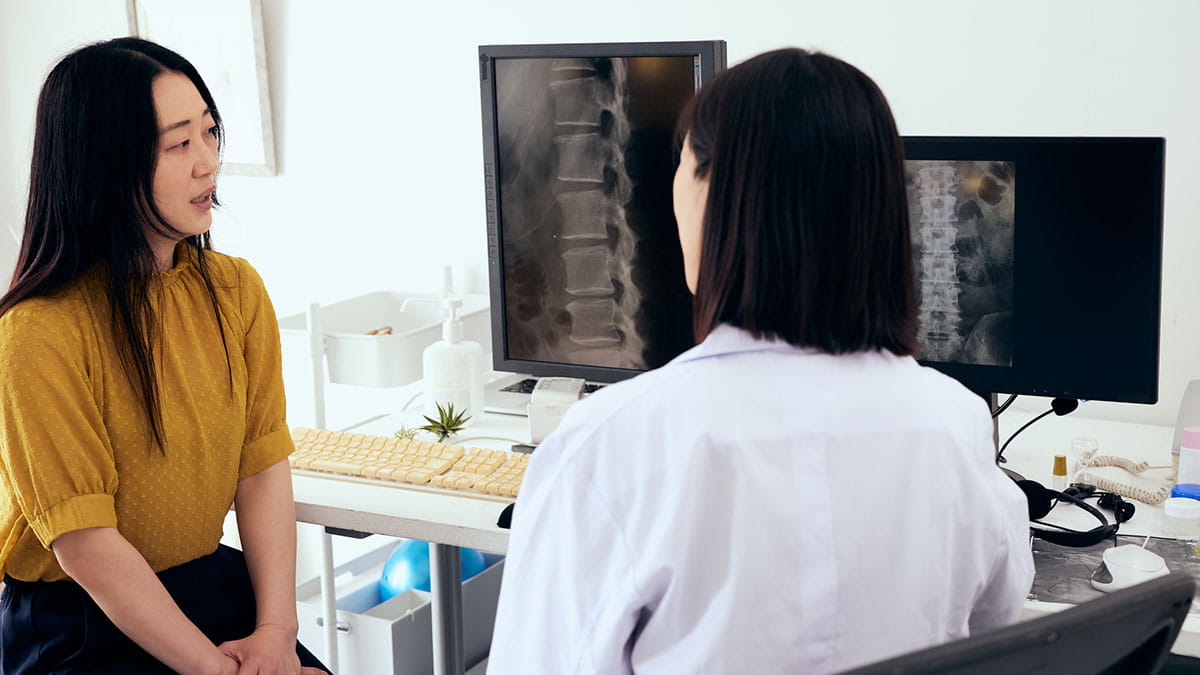Blog article
Understanding back surgery

While surgery is sometimes necessary, it’s not always the first or best option. This blog breaks down what you need to know about back surgery, from how the spine works and common conditions that lead to surgery, to what recovery looks like and when surgery might be avoidable.
Whether you're considering surgery or just want to understand your options, this guide is here to help you make informed decisions about your spine health.
Understanding the spine
Your spine is made up of a series of bones called vertebrae, separated by gel-filled cushions known as intervertebral discs. These discs act like shock absorbers, helping your spine stay flexible and protecting it from everyday movements like bending, lifting, and twisting.1
The lower part of your spine, called the lumbar spine, includes five large vertebrae and plays a key role in supporting your upper body, distributing weight, and allowing movement in all directions.1
Common back/spine conditions
Several conditions affecting the spine can lead to back pain and, in some cases, the need for back surgery. These include:
Bulging or herniated disc: Where the inner gel of a disc pushes out and presses on nearby nerves, causing pain, numbness, or weakness, especially in the legs (a condition known as sciatica).2
Degenerative disc disease: Where discs naturally wear down with age, reducing their ability to cushion the spine and sometimes leading to nerve compression.2
Scoliosis: A sideways curvature of the spine, scoliosis often develops in children and teens, although it can progress into adulthood and may require treatment if the curve becomes severe.3
Common types of back surgery
There are several types of back surgery, each designed to treat specific spinal problems. Here are some of the most common procedures:
Laminectomy: Removal of a small section of bone, with or without tissue, from the spine to create more space in the spinal canal and relieve pressure on the spinal cord or nerves.4
Lumbar microdiscectomy: Removal of part of a disc that has slipped out of place (herniated) and is pressing on a nerve in the spine.5
Spinal fusion: Joining two or more vertebrae (bones) in the spine so they can’t move. Surgeons use a small piece of bone or bone like material (also known as a bone graft), sometimes with screws or rods, to help the bones grow together over time.6
Artificial intervertebral disc replacement (AIDR): Removal of a damaged disc and replacement with a prosthetic one to allow more normal movement in the spine.7
When to have back surgery for bulging/herniated disc?
Back surgery for a bulging disc, also known as a slipped or herniated disc, is usually only considered when other treatments haven’t worked. In many cases, symptoms like pain, numbness, or weakness improve with rest, pain relief, and physiotherapy. But if the bulging disc is pressing on a nerve and causing ongoing leg pain (sciatica), or if symptoms are severe and affecting your ability to move or function, lumbar microdiscectomy may be recommended.5
The best way to ensure you’re getting the right care is to ask questions. Having an open conversation with your doctor and/or specialist can help you avoid unnecessary treatments and focus on what’s actually beneficial. Visit our blog, How do I know if a test or procedure is right for me? to learn more.
Choosing Wisely, an initiative funded by the Australian Government Department of Health and Aged Care, is a great first port of call for more information to help you make informed decisions about your health care.
What to expect after back surgery
Most people go home within a day or two after back surgery, depending on the type of procedure and how well their recovery begins. It’s normal to feel some pain, but this should be manageable with medication and shouldn’t stop you from moving around. Getting up and walking early helps with healing. In most cases, a physiotherapist will visit you the day after surgery to show you how to move safely and give you exercises to do at home. An occupational therapist may also provide tips and equipment to help with daily tasks.8
While soreness around the wound often improves within a couple of weeks, nerve-related symptoms like tingling or numbness in the legs or arms can take longer, sometimes up to 18 months. Everyone heals at a different pace, but most soft tissue healing happens within 4 to 6 weeks, with full strength returning by around 12 weeks.8
Exercise after back surgery
Gentle exercise is an important part of recovery after back surgery. In fact, you’ll usually start basic movements straight away, even if there’s some mild discomfort. A physiotherapist will guide you through safe exercises before you leave hospital and recommend a personalised plan based on your surgery and mobility.9
Most people are encouraged to do their exercises two to three times a day for at least eight weeks. These may include movements like pelvic tilts, knee-to-chest stretches, and gentle back extensions. As you heal, your physiotherapist can adjust your program to help you return to normal activities and reach your recovery goals.9
What are the symptoms of nerve damage after back surgery
Nerve damage after back surgery, sometimes referred to as Failed Back Surgery Syndrome (FBSS), can lead to ongoing discomfort and functional issues. Symptoms may vary from person to person, but common symptoms of nerve damage after back surgery include:10
- Persistent or worsening back or leg pain, even after surgery
- Burning, tingling, or electric shock-like sensations
- Numbness or reduced feeling in the legs, feet, or buttocks
- Muscle weakness or difficulty with coordination
- Pain that doesn’t follow a clear nerve path
- Changes in bladder or bowel control
If you notice any of these symptoms after surgery, especially if they’re new or getting worse, it’s important to speak with your doctor. Early diagnosis and a multidisciplinary approach to treatment can help manage symptoms and improve quality of life.
Why back surgery should be avoided
For most people with back pain, surgery isn’t necessary, and often isn’t helpful. In fact, more than 9 out of 10 cases of back pain are not caused by a serious medical problem and will improve with time, movement, and simple treatments. Back surgery is usually only considered when there’s a clear structural issue, like nerve compression, that hasn’t responded to other treatments.11
For non-specific back pain, where no exact cause is found, staying active, managing stress, and maintaining a healthy weight are often more effective than surgery. That’s why most experts recommend avoiding surgery unless it’s absolutely necessary and guided by a specialist’s advice.11,12
How HBF can help
If you and your doctor decide back surgery is the best course of action, HBF is here to help. Log in to myHBF or call 133 423 to check your level of cover and find a specialist using our Find a Provider tool.
If you have eligible extras cover with HBF, you may be able to claim benefits for services that support managing back pain without the need for surgery, such as:
- Physiotherapy: A physio can assess your condition, provide targeted exercises to strengthen your back, and help you maintain mobility while reducing discomfort.
- Exercise physiology: Get expert guidance on physical activity tailored to your needs, focusing on improving your strength, flexibility, and overall fitness to support your spine.
- Remedial massage: Recover with massages designed to ease muscle tension, reduce spasms, and alleviate back pain.
- Psychology: A psychologist can help you develop strategies to manage stress effectively, promoting better mental and physical health.
- Nutrition and dietetics: A dietitian can provide advice on a balanced diet to support weight management and overall wellness.



